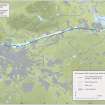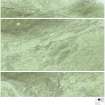Carrickstone
Altar (Roman)
Site Name Carrickstone
Classification Altar (Roman)
Canmore ID 45818
Site Number NS77NE 15
NGR NS 75487 76114
Datum OSGB36 - NGR
Permalink http://canmore.org.uk/site/45818
- Council North Lanarkshire
- Parish Cumbernauld
- Former Region Strathclyde
- Former District Cumbernauld And Kilsyth
- Former County Dunbartonshire
NS77NE 15 7548 7611.
(NS 7548 7611) Standing Stone (NR)
OS 6" map (1946)
On Carrickstone Farm is a large stone called the 'Standing Stone'. Though it bears no inscription, it has the appearance of a Roman altar. It has a hole in it, where, tradition says, Robert the Bruce planted his standard before the battle of Bannockburn.
NSA 1845 (J Watson)
A stone, standing on a knoll overlooking Dullatar and Cumbernauld, is said to have been a Roman altar. 'It is of buff coloured sand stone, and measures 3ft 1in in height, and 2ft 4ins by 1ft 9ins in breadth and width upon the top, narrowing considerably in the middle of its height, and expanding again to the bottom.'
In the top are some 'cup markings'. The 2 larger cups are about 8ins in diameter and 4 1/2ins in depth; the 2 smaller do not exceed 3ins in diameter.
W A Donelly 1897
This stone stands upon a stone base within a small fenced enclosure. It strongly resembles a Roman altar, with concave sides and ribbed capital and base. The top is pitted with 2 large, and 2 small "cups" - probably formed by both weathering and mutilation. The stone measures 0.4 x 0.6 x 4.1m high. The first part of a 19th century date can be faintly read on the south face.
The letters "CAR---" can be faintly traced on one of the ribs of the head of the stone, on the north face, but would appear to be of modern origin.
Visited by OS (JLD) 18 March 1957
This stone is a Roman Altar. The stone is now in a mutilated condition, and any original inscription has been obliterated. Its general shape, however, and such traces of mouldings as survive round its base and head show it to be undoubtedly Roman.
Information from K A Steer (RCAHMS), letter, 12 December 1957.
(NS 7548 7611) Roman Altar (R)
OS 1:10000 map (1976)
The weathered stone, still enclosed by its metal fence, is as described.
Visited by OS (MJF) 30 May 1980
Note (1982)
Carrickstone NS 754 761 NS77NE 15
A Roman altar stands within a small fenced enclosure on the S side of the road 350m W of Carrickstone farmhouse.
RCAHMS 1982
(NSA, viii ,Stirling, 141-2; Donelly 1897)
Publication Account (2008)
A 1:25000 scale map of the Antonine Wall was published by RCAHMS in 2008. The map shows the course of the Antonine Wall on a modern map base, including areas where the Wall is in public ownership or care and can be visited. The data had been collated as part of the project to prepare maps for the World Heritage Site nomination bid.
Note (April 2017)
A rare survivor
The Roman altar known as the Carrick Stone is one of the less well-known Roman sites in Scotland, but it is unusual in that it may still stand in its original location after nearly 2000 years, albeit in the surroundings of a housing estate. Standing about 150m above sea level, the site once commanded a fine view over the surrounding countryside and, to the north, the Roman forts of Castlecary and Westerwood, and the route of the Antonine Wall (one of Scotland’s World Heritage Sites). Like other altars along the route of the Wall, it may have been erected by a soldier stationed at one of the many forts or fortlets along its length.
Other better-preserved altars bear inscriptions, often in the form of a dedication to a Roman (or more exotic) deity. Some have a slight depression on their surface where offerings of wine, oil or flowers would have been placed. At Carrickstone, wind and rain have weathered the surface to such extent that neither feature survives, although the mouldings still visible on the base and top bear ready comparison with other examples. It is unusual in that there are several deep ‘cup-marks’ in the top which are not readily explained. They may be prehistoric markings, which attracted Roman re-use of the stone, or they may date to a much later period. One local story, that Robert the Bruce erected his standard here before Bannockburn, may prove impossible to substantiate and no ready explanation has been found for the significant wear around the stone’s waist.
Religious belief on the Antonine Wall
As many as 7000 soldiers were stationed along the Antonine Wall (built around AD 142), from countries as far away as modern Algeria, Spain and Syria. Some were legionaries with Roman citizenship but the majority were auxiliaries: men drawn into the army from across the Empire, sometimes by force. The altars that they erected along the line of the Wall help to tell the story of their lives, travel and beliefs and, where the inscriptions survive, tell us something of the daily life of the men (and women) at the Wall.
The inscription on the altar uncovered in 1963 at nearby Westerwood tells us that it was dedicated to Silvanus (a deity of woods and fields) by Vibia Pacata, the wife of the commanding officer Flavius Verecundas. This dedication is the most northerly record of the names of a married couple in the Roman Empire. More is known of Flavius’ career: before being stationed on the Antonine Wall he served in the province of Pannonia which extended across modern-day Austria and Hungary. Dedications to Silvanus, while rare in Scotland, are more common in this region.
Altars have been found at several other locations along the Antonine Wall, most commonly as isolated finds. In one remarkable discovery at Auchendavy, a group of four (and part of a fifth) were discovered by workmen constructing a canal in 1771. Four of the altars were dedicated by the same centurion, Marcus Cocceius Firmus. Marcus chose a wide range of gods and goddesses to appease at the four altars: Jupiter the Best and Greatest, and Victorious Victory; Apollo and Diana; the Genius of the Land of Britain; Mars, Minerva, the Campetres, Hercules, Epona and Victory. By including both Roman and local gods, he strove to cover all the bases.
Other examples include regimental altars that were housed in a shrine within the fort itself. These would have had pride of place, flanked by the regimental insignia and standards, all elements of an elaborate symbolic and religious practice which ensured the regiments’ good fortune. When forts were abandoned, altars seem to have been too heavy to take, but too important to leave in the open, although an outlier like Carrick may simply have been abandoned. The recovery of altars from pits, as at Auchendavy, or wells suggests that they may have been hidden to prevent them falling into enemy hands. That was the case with an altar recovered from a well outside the headquarters building at Bar Hill during excavation between 1902 and 1905. The dedication is by the ‘The First Cohort of the Baetasii, Roman citizens’, and the crisp carving has been well-preserved by its long rest in the well!
The Carrick Stone stands just to the south of the Antonine Wall. For more information about the Wall, visit the website (http://www.antoninewall.org) or download the interactive app.
Sources:
https://canmore.org.uk/site/45818/
Donelly W A (1897) ‘Note of a stone on the moor near Dullatur, called the Carrick Stone, shaped like a Roman altar, and having cups on its upper surface’, Proc Soc Antiq Scot 31, 228-30
Macdonald, G and Park, A (1906) The Roman Forts on The Bar Hill, Dumbartshire. Glasgow: Maclehose.
NSA (1834-1845) The new statistical account of Scotland by the ministers of the respective parishes under the superintendence of a committee of the society for the benefit of the sons and daughters of the clergy, Vol.8 (Dunbarton), 141-2
RCAHMS (1982) The archaeological sites and monuments of Cumbernauld and Kilsyth District and Strathkelvin District, Strathclyde Region, Series no 2 (rev.), 8
Patricia Weeks - Antonine Wall World Heritage Site Co-ordinator
































